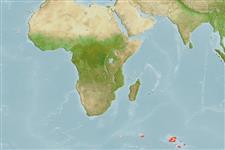Environment: milieu / climate zone / depth range / distribution range
Ecologia
marinhas demersal; intervalo de profundidade 0 - 91 m (Ref. 11892). Polar; 46°S - 54°S
Southern Ocean: Kerguelen and Crozet Islands; littoral and deeper waters of Heard Island.
Tamanho / Peso / Idade
Maturity: Lm ? range ? - ? cm
Max length : 8.2 cm TL macho/indeterminado; (Ref. 11892)
Descrição breve
Chaves de identificação | Morfologia | Morfometria
Espinhos dorsais (total) : 3 - 5; Raios dorsais moles (total) : 21 - 24; Raios anais moles: 15 - 19.
Found under rocks on the beach or in tide pools, but may also be found deeper (down to 80 m) among kelp and other algae (Ref. 5191). Feed on small crustaceans and common in littoral of all sub-Antarctic islands (Ref. 42041).
Life cycle and mating behavior
Maturidade | Reprodução | Desova | Ovos | Fecundidade | Larvas
Hureau, J.-C., 1990. Harpagiferidae. p. 357-363. In O. Gon and P.C. Heemstra (eds.) Fishes of the Southern Ocean. J.L.B. Smith Institute of Ichthyology, Grahamstown, South Africa. 462 p. (Ref. 5191)
Categoria na Lista Vermelha da IUCN (Ref. 130435: Version 2024-2)
Ameaça para o homem
Harmless
Utilização humana
Ferramentas
Relatórios especiais
Descarregue XML
Fontes da internet
Estimates based on models
Preferred temperature (Ref.
123201): 2.9 - 3.8, mean 3.2 °C (based on 18 cells).
Phylogenetic diversity index (Ref.
82804): PD
50 = 0.5010 [Uniqueness, from 0.5 = low to 2.0 = high].
Bayesian length-weight: a=0.00525 (0.00206 - 0.01336), b=3.10 (2.88 - 3.32), in cm total length, based on LWR estimates for this (Sub)family-body shape (Ref.
93245).
Nível Trófico (Ref.
69278): 3.2 ±0.5 se; based on size and trophs of closest relatives
Resiliência (Ref.
120179): Médio, tempo mínimo de duplicação da população 1,4 - 4,4 anos (Preliminary K or Fecundity.).
Fishing Vulnerability (Ref.
59153): Low vulnerability (10 of 100).
